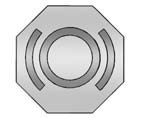Chevrolet Sonic Owner's Manual: Brake Fluid

The brake/clutch master cylinder reservoir is filled with DOT 3 brake fluid as indicated on the reservoir cap. See Engine Compartment Overview for the location of the reservoir.
There are only two reasons why the fluid level in the reservoir might go down:
- The fluid level goes down because of normal brake lining wear. When new linings are installed, the fluid level goes back up.
- A fluid leak in the brake/clutch hydraulic system can also cause a low fluid level. Have the brake/ clutch hydraulic system fixed, since a leak means that sooner or later the brakes and/or clutch will not work well.
Do not top off the brake/clutch fluid. Adding fluid does not correct a leak. If fluid is added when the linings are worn, there will be too much fluid when new brake linings are installed. Add or remove brake fluid, as necessary, only when work is done on the brake/clutch hydraulic system.
Warning
If too much brake fluid is added, it can spill on the engine and burn, if the engine is hot enough. You or others could be burned, and the vehicle could be damaged. Add brake fluid only when work is done on the brake/clutch hydraulic system.
When the brake/clutch fluid falls to a low level, the brake warning light comes on. See Brake System Warning Light.
 Replacing Brake System Parts
Replacing Brake System Parts
The braking system on a vehicle is complex. Its many parts have to be of top
quality and work well together if the vehicle is to have really good braking. The
vehicle was designed and tested with ...
 What to Add
What to Add
Use only new DOT 3 brake fluid from a sealed container. See Recommended Fluids
and Lubricants.
Always clean the brake/clutch fluid reservoir cap and the area around the cap
before removing it. Th ...
Other materials:
Steering Linkage Inner Tie Rod Replacement
Steering Linkage Inner Tie Rod Replacement
Callout
Component Name
Preliminary Procedures
Raise and support the vehicle. Refer to Lifting and Jacking the
Vehicle.
Remove the steering gear boot. Refer to Steering Gear Boot ...
Torque Steer Description
A vehicle pulls or leads in one direction during hard acceleration. A vehicle
pulls or leads in the other direction during deceleration.
The following factors may cause torque steer to be more apparent on a particular
vehicle:
A slightly smaller diameter tire on the right front increa ...
Drive Range, Fifth Gear Default (Gen 2)
If the transmission encounters an electrical component malfunction, the transmission
will default to Fourth gear. All solenoids will default to their normal state. If
the torque converter clutch is applied, it will release. The transmission will remain
in Drive Range?Fourth Gear Default until ...
0.0058
